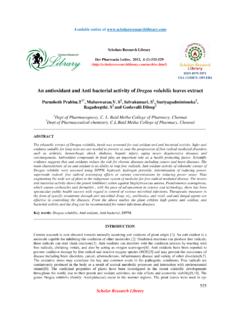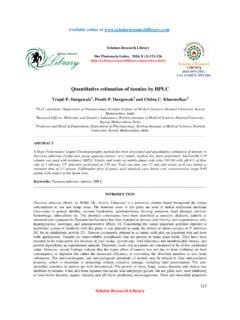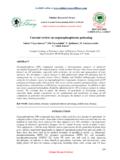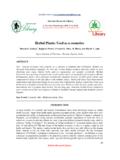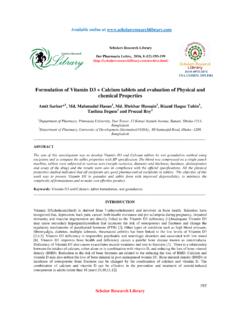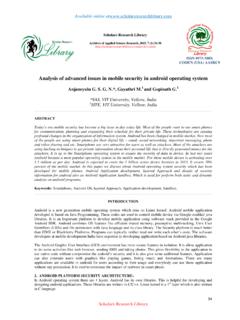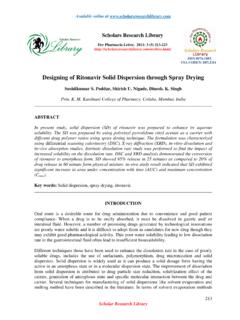Transcription of Traditional uses, phytochemistry and pharmacological ...
1 available online at Scholars Research Library Der Pharmacia Lettre, 2011, 3(2): 141-164 ( ) ISSN 0975-5071 USA CODEN: DPLEB4 141 Scholar Research Library Traditional uses, phytochemistry and pharmacological properties of Moringa oleifera plant: An overview Garima Mishra1*, Pradeep Singh1, Ramesh Verma1, Sunil Kumar1, Saurabh Srivastav1, K. K. Jha1 and R. L. Khosa2 1 Department of Pharmacognosy, Teerthanker Mahaveer College of Pharmacy, Teerthanker Mahaveer University, Moradabad, Uttar Pradesh, India, 2 Deptt. of Pharmacy, Bharat Institute of Technology, Partapur Bypass, Delhi Road, Meerut _____ ABSTRACT Moringa oleifera, an important medicinal plant is one of the most widely cultivated species of the family Moringaceae. It is highly valued from time immemorial because of its vast medicinal properties. The present article provides all necessary information regarding its phytochemical investigations, pharmacological actions and medicinal properties like anemia, anxiety, asthma, blackheads, blood impurities, bronchitis, catarrh, chest congestion, cholera, conjunctivitis, cough, diarrhoea, eye and ear infections, fever, abnormal blood pressure, pain in joints, scurvy, semen deficiency, headaches and tuberculosis.
2 It gives an account of all the data and reports which have been appeared to prove its medicinal and nutritional importance. Its utility as a non-food product has also been extensively described. Every part of Moringa is said to have beneficial properties that can serve humanity so the whole plant can be extensively studied for further research aspects. Keywords: Moringa oleifera, Drumstick tree, Horse-radish tree, cardiovascular, anti-inflammatory, antimicrobial. _____ INTRODUCTION In the last few decades there has been an exponential growth in the field of herbal medicine. It is getting popularized in developing and developed countries owing to its natural origin and lesser side effects [1]. Herbal drugs constitute a major share of all the officially recognized systems of health in India viz. Ayurveda, Yoga, Unani, Siddha, Homeopathy and Naturopathy, except Garima Mishra et al Der Pharmacia Lettre, 2011, 3(2):141-164 _____ 142 Scholar Research Library Allopathy.
3 More than 70% of India's billion populations still use these non-allopathic systems of medicine [2]. In many developing countries, a large proportion of the population relies on Traditional practitioners and their armamentarium of medicinal plants in order to meet health care needs. Although modern medicines may exist side-by-side with such Traditional practice, herbal medicines have often maintained their popularity for historical and cultural reasons. Such products have become more widely available commercially, especially in developed countries. Use of herbal medicines in developed countries has expanded sharply in the latter half of the twentieth century. In India, herbal drugs are an integral part of The Indian System of Medicine (Ayurveda) which is an ancient and mainstream system [3].
4 The evaluation of various plant products according to their Traditional uses and medicinal value based on their therapeutic efficacy leads to the discovery of newer and recent drugs for treating various ailments. This fact forms the basis for the development of new drugs from various plant sources. One of such plants of medicinal value is Moringa olifera, belonging to the family Moringaceae, commonly known as sahajan in Hindi, Horse radish in English. It is a small, fast, growing, evergreen, or deciduous tree that usually grows upto 10 or 12 m in height. It is distributed among Sub Himalayan Tracts, Assam, Bengal and Peninsular India [4]. Various properties are attributed to it like antispasmodic, diuretic, expectorant and abortifacient [5]. TAXONOMIC CLASSIFICATION Kingdom - Plantae Sub kingdom - Tracheobionta Super Division - Spermatophyta Division - Magnoliophyta Class - Magnoliopsida Subclass - Dilleniidae Order - Capparales Family - Moringaceae Genus - Moringa Species - Oleifera BOTANICAL DESCRIPTION Synonyms Latin - Moringa oleifera Sanskrit - Subhanjana Hindi - Saguna, Sainjna Gujarati - Suragavo Tamil - Morigkai Telugu - Mulaga, Munaga Malayalam - Murinna, Sigru Punjabi - Sainjna, Soanjna Unani - Sahajan Ayurvedic - Akshiva, Haritashaaka, Raktaka.
5 Tikshnagandhaa Arabian - Rawag French - Moringe graine ail e, Morungue Spanish - ngela, Ben, Moringa Portuguese - Moringa, Moringueiro Chinese - La ken English - Drumstick tree, Horseradish tree, Ben tree Garima Mishra et al Der Pharmacia Lettre, 2011, 3(2):141-164 _____ 143 Scholar Research Library Geographical Source The tree is wild in the Sub-Himalayan tracts from Chenab to Oudh. It grows at elevations from sea level to 1400 m. It is very commonly cultivated near houses in Assam, Bengal and peninsular India. It is a prolific coppicer [4]. It is also cultivated in north-eastern Pakistan, north-eastern Bangladesh, Sri Lanka, West Asia, the Arabian peninsula, East and West Africa, throughout the West Indies and southern Florida, in Central and South America from Mexico to Peru, as well as in Brazil and Paraguay [6].
6 Morphology Moringa oleifera is a small, fast-growing evergreen or deciduous tree that usually grows as high as 9 m, with a soft and white wood and corky and gummy bark. Roots have the taste of horse-radish. Leaves are longitudinally cracked leaves, 30-75 cm long main axis and its branch jointed, glandular at joints, leaflets are glabrous and entire. The leaflets are finely hairy, green and almost hairless on the upper surface, paler and hairless beneath, with red-tinged mid-veins, with entire (not toothed) margins, and are rounded or blunt-pointed at the apex and short-pointed at the base. The twigs are finely hairy and green. Flowers are white, scented in large axillary down panicles, pods are pendulous, ribbed, seeds are 3-angled [4, 6]. Compound leaf; paler lower surfaces of leaflets Flower panicle Traditional Uses Traditionally, the plant is used as antispasmodic, stimulant, expectorant and diuretic.
7 Fresh root is acrid and vesicant (has the taste of horse-radish). Internally it is used as stimulant, diuretic and antilithic. Gum is bland and mucilaginous. Seeds are acrid and stimulant. Bark is emmenogogue and even abortifacient, antifungal, antibacterial. Flowers are cholagogue, stimulant, tonic and diuretic and useful to increase the flow of bile. The plant is also a cardiac circulatory tonic and antiseptic. [5] Pods are antipyretic, anthelmintic; fried pods are used in diabetes. Root juice is employed in cardiac tonic, antiepileptic. Used for nervous debility, asthma, enlarged liver and spleen, deep-Garima Mishra et al Der Pharmacia Lettre, 2011, 3(2):141-164 _____ 144 Scholar Research Library seated inflammation and as diuretic in calculus affection. Decoction is used as a gargle in hoarseness and sore throat.
8 Root and fruit are antiparalytic. Leaf juice is used in hiccough (emetic in high doses); cooked leaves are given in influenza and catarrhal affections. Root-bark is used as antiviral, anti-inflammatory, analgesic. Stem-bark and flowers are hypoglyceamic. Infusion of seed is anti-inflammatory, antispasmodic and diuretic, also given in venereal diseases. Along with other therapeutic applications, The Ayurvedic Pharmacopoeia of India indicated the use of the dried root bark in goitre, glycosuria and lipid disorders (also dried seeds), and leaf, seed, root bark and stem bark in internal abscess, piles. [7] Dosage : Leaf 10 20ml. juice; root bark 2 5 g powder; stem bark 2 5g powder; seed 5 10 g powder. Leaf, flower, fruit, seed, bark, root 1 3 g powder; 50 100 ml decoction. [8, 9]. phytochemistry U. Eilert et al. (1981) reported the isolation of 4(alpha-L-Rhamnosyloxy) benzyl isothiocyanate form seeds of Moringa oleifera [10].
9 Villasenor et al. (1989) reported certain biosynthetically and chemically related compounds from roasted seeds of Moringa oleifera. Their structures have been elucidated by spectral analysis as 4(-L-rhamnosyloxy) phenylacetonitrile, 4-hydroxyphenylacetonitrile, and 4-hydroxyphenyl-acetamide [11, 12]. S. Faizi et al. (1994) reported the isolation of two nitrile glycosides from the ethanolic extracts of Moringa oleifera leaves, niazirin and niazirinin and three mustard oil glycosides, 4-[(4'-O-acetyl-alpha-L-rhamnosyloxy)ben zyl]isothiocyanate, niaziminin A, and niaziminin B. Niazirinin is a new compound. Niaziminins A and B have previously been obtained from the left extract as a mixture, while 4-[(4'-O-acetyl-alpha-L-rhamnosyloxy)ben zyl]isothiocyanate is new from this source. Structural determination was accomplished by means of spectroscopic methods including appropriate 2D nmr experiments and chemical reactions.
10 This is the first report of the isolation of nitriles, an isothiocyanate, and thiocarbamates from the same plant species [13]. S. Faizi et al. (1995) isolated six new and three synthetically known glycosides from the leaves of Moringa oleifera, employing a bioassay-directed isolation method on the ethanolic extract. Most of these compounds, bearing thiocarbamate, carbamate or nitrile groups, are fully acetylated glycosides, which are very rare in nature. Elucidation of the structures was made using chemical and spectroscopic methods, including 2D NMR techniques [14]. S. Faizi et al. (1998) isolated two new compounds from the ethanolic extract of whole pods of Moringa oliefera, O-[2'-hydroxy-3'-(2"-heptenyloxy)]-propy l undecanoate and O-ethyl-4-[(alpha-L-rhamnosyloxy)-benzyl ] carbamate along with the known substances like methyl p-hydroxybenzoate and beta-sitosterol [15].
